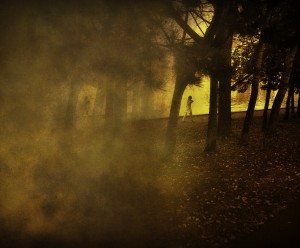Endings and Leavings | Part 2 of a 8-part series on the deeper Self that awakens in laboring through grief, living through loss, and embracing endings as the seedbed of new beginnings.
“The past is never dead. It’s not even past.” (William Faulkner)
Perhaps the most confusing part of “endings” is how they can leave us feeling both stuck and uprooted – often at the same time.
 It is the earthquake-like nature of many endings, which are often complicated by the lingering, unresolved grief of endings long past. Whether we experience endings as traumatic shock-waves or subtle tremors, it can be hard to regain an emotional footing on our inner landscape. For all their commotion, endings can also trap us in time. We can’t seem to move, yet everything is shifting underneath.
It is the earthquake-like nature of many endings, which are often complicated by the lingering, unresolved grief of endings long past. Whether we experience endings as traumatic shock-waves or subtle tremors, it can be hard to regain an emotional footing on our inner landscape. For all their commotion, endings can also trap us in time. We can’t seem to move, yet everything is shifting underneath.
Liminal Place and Calling
Endings thrust us into an in-between space known as “liminality.” Liminal space is experienced – often judged and resisted – as an arid, wandering, disorienting no-man’s land.
Christian psychologist and author Dan Allender describes endings as “liminal” in that they strand a person between the painful past that we fear revisiting, and the future’s daunting uncertainty.
Liminality is more than a state or place. It’s also a calling that so many Christians miss or try to avoid. Scripture is full of these liminal stories. Remember the Israelites’ Exodus journey into the desert. They were fleeing from (and later yearning for) Egyptian bondage of their past, yet shrinking back from the giants of Canaan occupying their future.
Or, recall the disciples hiding out in the Upper Room after Jesus’ death. What died or “ended” with Jesus on the cross was the disciples’ rigid imagination of heroic “savior” and their immediate expectations of a new Kingdom usurping Roman rule. The resurrection that was at hand, they couldn’t yet see.
Liminal Tensions: A Present-Tense Life
To judge a person’s liminal journey as evidence of unbelief or flawed character is too simplistic. It misses the intentional, invitational nature of liminal space. God is most active in the holy gray, the sacred in-between. We are called into liminality, to learn how to bear its tension and to let it shape us into people who are more human, more trusting, and capable of bigger dreams.
One of the best pictures of liminality is the “crisis” of the chrysalis, that fragile and uncertain space between the caterpillar’s ending and the butterfly’s beginning – where it seems like nothing is happening.
In our fear of failure, in our risk-averse culture, we tend to rigidly live in the past or the future. But liminality can stretch us into a more flexible, receptive state, where our minds can move fluidly between past, present and future. We learn to embrace and grieve endings (bravely reading our past), and to actively wait (anticipating without forcing the future) – all while becoming more present to the here-and-now.
Liminal tension pulls us into a present-tense way of living. The weak-ego self fiercely resists the Core Self’s efforts to slow down, to sense and feel, to pay attention in the moment.
The present is the only place we can be truly connected to ourselves and one another.
Emotional Trauma: Memory Interrupted
 Some endings are more difficult to bear than others. A sudden death or prolonged dying. Emotional or physical abuse. Divorce. Any loss laced with themes of rejection and betrayal.
Some endings are more difficult to bear than others. A sudden death or prolonged dying. Emotional or physical abuse. Divorce. Any loss laced with themes of rejection and betrayal.
These tragedies may be so over-bearing, so traumatic for those experiencing or observing them, that the brain and its memory-making mechanism instinctively disengages or “dissociates” in order to cope.
So, while liminal tension inspires growth, it is also subject to a neurochemical reality: the traumatic “endings” from our past can end up “stuck” in our present.
When the full impact of emotional trauma is blunted by dissociation, then the brain cannot process and properly “file away” (encode) the memory. These disorganized pieces of memory – fragmented by fear, pain and shame – become lodged in a part of the brain that can be difficult to access through cognitive awareness alone. The body remembers, however. The body at a cellular level holds the memory in ways the mind cannot.
Relocating the Past
 The body and the deeper mind cope with trauma by maintaining a hyper-vigilance towards people, situations, or sensations that may “trigger” the pain of the past – in an effort to avoid it.
The body and the deeper mind cope with trauma by maintaining a hyper-vigilance towards people, situations, or sensations that may “trigger” the pain of the past – in an effort to avoid it.
In this sense, the past is too easily activated in the present. If the brain had been able to fully experience, process and “time-stamp” the event in the moment, it could have receded into the past where it belongs.
It’s this “un-ending” and “re-living” aspect of unresolved grief, and poorly named losses, that so complicates the healing process.
A healthier person can more freely access the past, using it to help inform here-and-now thoughts and feelings – but without letting the past “re-enact” itself or dictate life in the present.
Christian Counseling: From Coping To Living
The brain’s ability to dissociate in the moment is a brilliant coping strategy. But it’s no way to live.
What was adaptive coping in the moment becomes maladaptive over time. The body and brain need to experience new, safer ways of trusting, instead of rigidly reacting to unresolved grief.
The past is not to be discarded – but it does need to be well placed. We are called to practice “well-ending.”
Far more than your present or future, your past is what holds the most potential for change and transformation. The facts and content are fixed. But your perspective on your past is open to new meaning and a changing relationship to it. In Part 3 we’ll look at how we can bear and beautify the scars that endings leave.
Allender, Dan. April 26, 2015. “Endings – The Allender Center Podcast,” theallendercenter.org.
Photos
“Wet,” courtesy of Mikael Tigerstrom, Flickr CreativeCommons (CC BY 2.0); “Do not go gentle into that good






